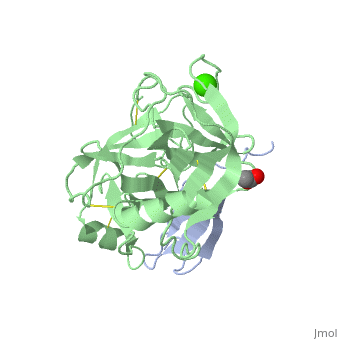2xtt
From Proteopedia
Bovine trypsin in complex with evolutionary enhanced Schistocerca gregaria protease inhibitor 1 (SGPI-1-P02)
Structural highlights
FunctionSGP1_SCHGR In vitro, SGPI-1/SGCI is active against alpha-chymotrypsin and trypsin while SGPI-2/SGTI is active against alpha-chymotrypsin and pancreatic elastase. Publication Abstract from PubMedThe mechanism of serine proteases prominently illustrates how charged amino acid residues and proton transfer events facilitate enzyme catalysis. Here we present an ultrahigh resolution (0.93 A) X-ray structure of a complex formed between trypsin and a canonical inhibitor acting through a substrate-like mechanism. The electron density indicates the protonation state of all catalytic residues where the catalytic histidine is, as expected, in its neutral state prior to the acylation step by the catalytic serine. The carboxyl group of the catalytic aspartate displays an asymmetric electron density so that Odelta2-Cgamma bond appears to be a double bond, with Odelta2 involved in a hydrogen bond to His-57 and Ser-214. Only when Asp-102 is protonated on Odelta1 atom a DFT simulation could reproduce the observed electron density. The presence of a putative hydrogen atom is also confirmed by a residual mFobs-DFcalc density above 2.5 sigma next to Odelta1. As a possible functional role for the neutral aspartate in the active site, we propose that in the substrate bound form the neutral aspartate residue helps to keep the pKa of the histidine sufficiently low, in the active neutral form. When the histidine receives a proton during the catalytic cycle, the aspartate becomes simultaneously negatively charged providing additional stabilization for the protonated histidine and indirectly to the tetrahedral intermediate. This novel proposal unifies the seemingly conflicting experimental observations, which were previously seen as either supporting the charge relay mechanism or the neutral-pKa histidine theory. The catalytic aspartate is protonated in the Michaelis complex formed between trypsin and an in vitro evolved substrate-like inhibitor: a refined mechanism of serine protease action.,Wahlgren WY, Pal G, Kardos J, Porrogi P, Szenthe B, Patthy A, Graf L, Katona G J Biol Chem. 2010 Nov 21. PMID:21097875[1] From MEDLINE®/PubMed®, a database of the U.S. National Library of Medicine. See AlsoReferences
| ||||||||||||||||||||
Categories: Bos taurus | Large Structures | Schistocerca gregaria | Graf L | Kardos J | Katona G | Pal G | Patthy A | Porrogi P | Szenthe B | Wahlgren WY

